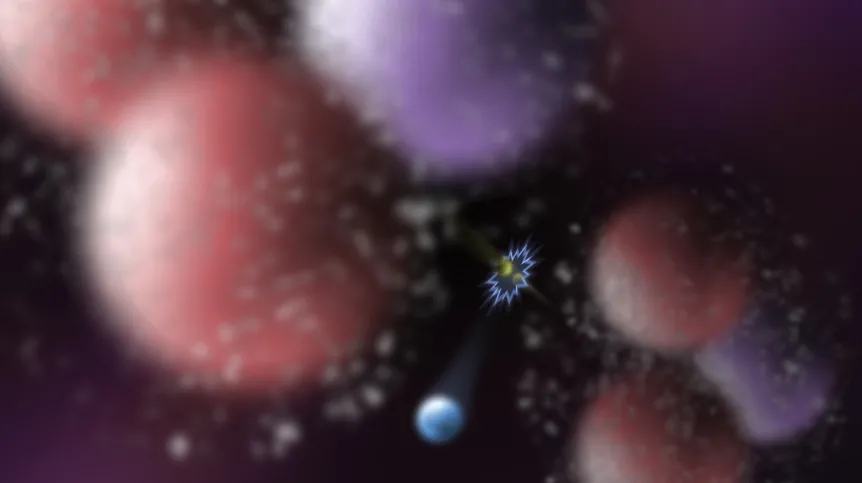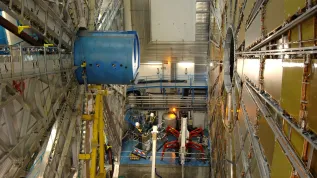
After 12 years of detailed research into the properties of the Higgs boson, there is no indication that it will be possible to extend the Standard Model with elements of new physics - new analyses involving Polish scientists show.
The Standard Model is a complex theoretical structure constructed in the 1970s to coherently describe the currently known elementary particles of matter (quarks, as well as electrons, muons, tau and neutrinos), electromagnetic forces (photons) and nuclear forces (gluons in the case of strong interactions, W and Z bosons in the case of weak interactions).
The widespread belief among scientists in the need for the existence of new physics results from the fact that a number of fundamentally important questions cannot be answered with the Standard Model.
• Why do elementary particles have the masses they do?
• What is dark matter made of, traces of which are so clearly visible in the cosmos?
• What is the reason for the predominance of matter over antimatter in the Universe?
• How does gravity work?
The hope for extending the Standard Model was the Higgs boson, discovered in the LHC accelerator detectors over a decade ago (announced in 2012). The Higgs boson plays a key role in the mechanism responsible for giving masses to the other elementary particles. It has proven to be a particle so difficult to produce and observe that, despite the passage of time, its properties are still not known with satisfactory accuracy.
Now, further research published in the prestigious Physical Review Letters describes the properties of this 'God particle' in even greater detail.
An international group of theoretical physicists took part in the research project, including scientists from the Institute of Nuclear Physics at the Polish Academy of Sciences in Kraków, RWTH Aachen University (RWTH) in Aachen and Max-Planck-Institut für Physik (MPI) in Garching near Munich.
'It appears that no harbingers of new physics are visible within the mechanisms responsible for the formation of Higgs bosons that we are investigating - at least for the time being', the study co-author Dr. Rene Poncelet (Institute of Nuclear Physics PAS) says.
'For a physicist, one of the most important parameters associated with any elementary or nuclear particle is the cross section for a specific collision. This is because it gives us information on how often we can expect the particle to appear in collisions of a certain type. We have focused on the theoretical determination of the Higgs boson cross section in gluon-gluon collisions. They are responsible for the production of about 90% of the Higgs, traces of whose presence have been registered in the detectors of the LHC accelerator’, says Dr. Poncelet.
Professor Michał Czakon (RWTH) adds: 'The essence of our work was the desire to take into account, when determining the active cross section for the production of Higgs bosons, certain corrections that, due to their apparently small contribution, are usually neglected, because ignoring them significantly simplifies the calculations. It’s the first time we have succeeded in overcoming the mathematical difficulties and determining these corrections'.
The secondary corrections calculated in the paper, contribute almost one-fifth to the value of the sought active cross section. This compares with third-order corrections of three per cent (but which reduce the computational uncertainties to just one per cent).
A novelty in the paper was to take into account the effect of beauty quark masses, leading to a small but noticeable shift of about one per cent.
The latest achievement of theoretical physicists from the Institute of Nuclear Physics PAS, RWTH and MPI does not definitively rule out the presence of new physics in the phenomena accompanying the birth of the Higgs boson. Much may change when data from the gradually starting fourth research cycle of the Large Hadron Collider begin to be analysed.
The increasing number of observations of new particle collisions may make it possible to narrow down the measurement uncertainties in such a way that the measured range of permissible cross sections for Higgs production no longer coincides with that defined by theory. Whether or not this will happen, physicists will find out in a few years.
'For now, the Standard Model can feel safer than ever - and this fact is slowly starting to become the most surprising discovery made with the LHC', says the research team.
The release describing the research project is available on the Institute of Nuclear Physics PAS website.
PAP - Science in Poland
lt/ agt/ kap/
tr. RL













